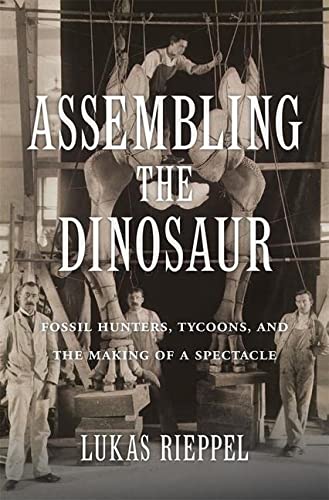Assembling the Dinosaur: Fossil Hunters, Tycoons, and the Making of a Spectacle – Lukas Rieppel

Assembling the Dinosaur: Fossil Hunters, Tycoons, and the Making of a Spectacle by Lukas Rieppel is a delightful and stimulating read about the nature of collecting and displaying dinosaur bones during the Progressive Era. As is such, Andrew Carnegie and other monopoly capitalists dominate a narrative about dinosaur bones, a surprising revelation. But Rieppel’s goals is not to give a history exclusively about dinosaurs, but instead highlight how wealthy philanthropists like Carnegie used the collection and display of dinosaur bones in non-profit scientific institutions, most notably museums, to signal their wealth and status as well as to fulfill a narrative of uplifting the common man in contradiction to their brutal labor practices.
Dinosaur collecting and display became a trend, but it was always a capitalist venture, from the men who found the bones to the men who purchased and displayed them. Scientists also figured prominently as they tried to make a scientific narrative out of dinosaur bones that imparted far more questions than the answered. Scientists and capitalists worked together to use paleontological history to further their own needs and desires, and these often intersected.
Rieppel’s book is a great read. He balances science and capitalism well, and reveals a new side to capitalist philanthropy during the Progress Era, an area of interest readers might not know anything about. He also borrows from space historians who claim space programs as way to indicate scientific advance and prowess to other countries during the space race, something called “signaling,” a term Rieppel also makes use of. Here, capitalists and scientists made dinosaurs the subject of envy. Assembling the Dinosaur is not a history of the dinosaur, but a history of the collection and display of dinosaur bones. Rieppel lays bare mysteries that accompanied the dinosaurs and, in his closing chapter, argues that the dominance of the Chinese in finding dinosaur bones makes the issue political once again, though perhaps science crosses all borders. This is a well-written and researched book that would do well in both undergraduate and graduate classrooms.
I will note that this is a history of white, mostly elite, men. There are no minority characters and there is scanty coverage of how the general public received the displays of dinosaur bones. Elaboration on these issues would be welcome, but Assembling the Dinosaur is a good start.
